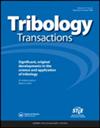Effect of iron powder type on friction and wear properties of copper based friction powder metallurgy material
IF 2.2
3区 工程技术
Q2 ENGINEERING, MECHANICAL
引用次数: 0
Abstract
Abstract:The sintered copper based friction materials for high-speed train brake pads have a complex composition, which should possess good physical, mechanical and tribological properties in practical applications. In this paper, four kinds of friction materials were prepared by powder metallurgy technology and the effects of iron powders on the microstructural and tribological properties of copper based friction materials were characterized by scanning electron microscope (SEM) and X-Ray diffraction (XRD). The results showed that the iron powder as the enhanced component could effectively change the friction and wear properties of the experimental materials. The copper based friction materials containing hydroxy iron (1-5μm) have a relatively higher coefficient of friction, the friction coefficient was significantly improved by 16.8% compared with reduced iron under a rotation speed is 4000 r/min. The friction coefficient of friction material containing water atomized iron powder is relatively reliable with 3000-7000 r/min speed range. In the high speed environment, the friction surface of material containing reduced iron or hydroxy iron(1-5μm)mainly are cracks and brittle fractures, and the material containing hydroxy iron(10μm)or water atomized iron has obvious layered structure.Keywords: copper based friction materialsfriction and wearpowder metallurgyDisclaimerAs a service to authors and researchers we are providing this version of an accepted manuscript (AM). Copyediting, typesetting, and review of the resulting proofs will be undertaken on this manuscript before final publication of the Version of Record (VoR). During production and pre-press, errors may be discovered which could affect the content, and all legal disclaimers that apply to the journal relate to these versions also. Competing Interests:The authors have no relevant financial or non-financial interests to disclose.Additional informationFundingThis work was supported by Key Scientific and Technological Project of Henan Province (Grants No: 232102230055), the National Natural Science Foundation of China (Grants No: U1904175) and Postgraduate Education Reform and Quality Improvement Project of Henan Province (Grants No: YJS2022JD50).铁粉类型对铜基摩擦粉末冶金材料摩擦磨损性能的影响
摘要高速列车刹车片用烧结铜基摩擦材料成分复杂,在实际应用中应具有良好的物理、机械和摩擦学性能。采用粉末冶金技术制备了四种铜基摩擦材料,利用扫描电子显微镜(SEM)和x射线衍射仪(XRD)表征了铁粉对铜基摩擦材料显微组织和摩擦学性能的影响。结果表明,铁粉作为增强组分可以有效地改变实验材料的摩擦磨损性能。含羟基铁(1 ~ 5μm)的铜基摩擦材料具有较高的摩擦系数,在转速为4000 r/min时,摩擦系数较还原铁显著提高16.8%。含水雾化铁粉摩擦材料的摩擦系数相对可靠,转速范围在3000 ~ 7000 r/min。在高速环境下,含还原铁或羟基铁(1-5μm)材料的摩擦表面主要是裂纹和脆性断裂,含羟基铁(10μm)或水雾化铁的材料具有明显的层状结构。关键词:铜基摩擦材料摩擦磨损粉末冶金免责声明作为对作者和研究人员的服务,我们提供这个版本的接受手稿(AM)。在最终出版版本记录(VoR)之前,将对该手稿进行编辑、排版和审查。在制作和印前,可能会发现可能影响内容的错误,所有适用于期刊的法律免责声明也与这些版本有关。竞争利益:作者没有相关的经济或非经济利益需要披露。项目资助:河南省重点科技项目(批准号:232102230055)、国家自然科学基金项目(批准号:U1904175)、河南省研究生教育改革与质量提升项目(批准号:YJS2022JD50)。
本文章由计算机程序翻译,如有差异,请以英文原文为准。
求助全文
约1分钟内获得全文
求助全文
来源期刊

Tribology Transactions
工程技术-工程:机械
CiteScore
3.90
自引率
4.80%
发文量
82
审稿时长
4 months
期刊介绍:
Tribology Transactions contains experimental and theoretical papers on friction, wear, lubricants, lubrication, materials, machines and moving components, from the macro- to the nano-scale.
The papers will be of interest to academic, industrial and government researchers and technologists working in many fields, including:
Aerospace, Agriculture & Forest, Appliances, Automotive, Bearings, Biomedical Devices, Condition Monitoring, Engines, Gears, Industrial Engineering, Lubricants, Lubricant Additives, Magnetic Data Storage, Manufacturing, Marine, Materials, MEMs and NEMs, Mining, Power Generation, Metalworking Fluids, Seals, Surface Engineering and Testing and Analysis.
All submitted manuscripts are subject to initial appraisal by the Editor-in-Chief and, if found suitable for further consideration, are submitted for peer review by independent, anonymous expert referees. All peer review in single blind and submission is online via ScholarOne Manuscripts.
 求助内容:
求助内容: 应助结果提醒方式:
应助结果提醒方式:


